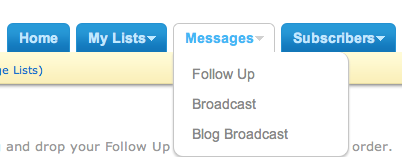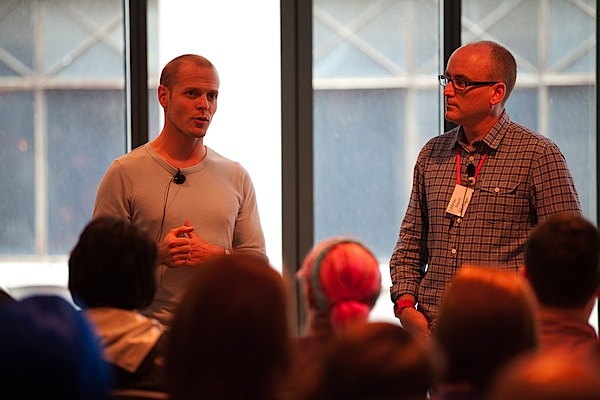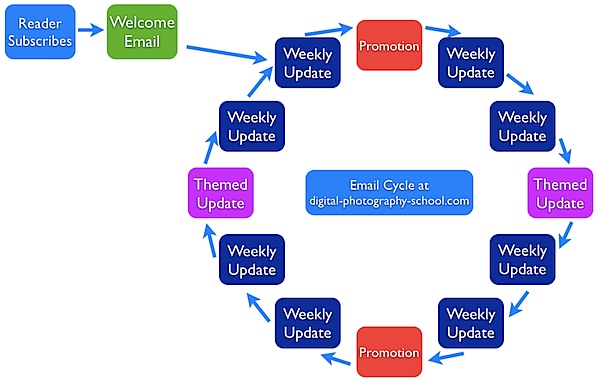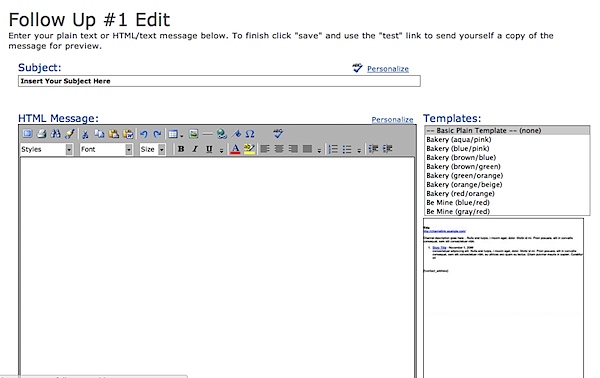 | Make Money Blogging http://www.problogger.net рекомендовать друзьям >> |
- Creating Online Courses 101
This guest post is by Peep Laja of Traindom.
Blog monetization is a tough challenge for a lot of people. In this post I’ll help you overcome it.
The best way to make money with your blog (even when your traffic is low) is by selling your own digital products—especially online courses that teach people to do or achieve something.
Content marketing (blogging, social media) is the way to position yourself as an expert and build relationships with your audience. Both will make it easy for you to sell a course on your blog.
If you have your own products, you control the marketing, the pricing, and the content, and you take 100% of the profit. That sure beats everything else.If you’re doing it right, you’re already teaching people through blogging, so teaching shouldn’t be new to you.
Ebooks might not cut it
The easiest way to package paid content would be PDF ebooks. They’re really easy to create, but they also have many problems:
- Low perceived value: People know how to create pdf ebooks—just choose “Save As” in MS Word. So your PDF has a perceived value that’s much lower than the $13 real book you can buy from Amazon. This means you cannot charge a high price for your PDF ebook.
- Ebooks are static: Once they’re out there, they’re out there. You cannot add stuff, correct material, or fix typos.
- Ebooks are way too easy to
sharepirate: Someone buys your $19 ebook and then attaches it to his email and blasts it everywhere. Or uploads to his blog. Or better yet, shares with the world via torrents. So much for your ebook income. - People don’t want to just read any more: They want to watch videos and use a variety of media.
- There are no analytics: Which chapter is most popular? What are your readers most interested in? You will never know.
- There’s no interaction: People read a chapter in your ebook and have questions. But alas, no interaction is possible.
- There’s no recurring income: Money is in the repeat purchases. You can only sell PDFs for a single payment. So kiss goodbye to the potential of a membership site.
So, what’s better than ebooks? Online courses. They have none of the shortcomings mentioned in this list—in fact it’s quite the opposite.
First, solve a problem
If you decide to build a course for your site, your journey begins with understanding the problem you’re solving. People don’t want to buy online courses. They want to solve their problems.
If your course doesn’t solve a problem, it will be difficult—if not impossible—to sell.
Solving the core issue should be your #1 priority—everything else is extra. You have to get this right.
Your course should:
- give solutions to the problems your readers want to solve
- give solutions to the problems your readers don’t know they have
- be practical and have actionable content (the more specific, the better)
- use a mix of media: text alone is too boring; all video can be too time-consuming (with text they can just scroll down or search for something specific, whereas in video or audio, they don’t know what’s coming).
So your first goal should be to understand what the users’ problems are. Pay attention to what people are saying and asking about your field on Twitter, LinkedIn Answers, relevant forums, and blogs.
Determine the ultimate goals for the end user—why is this person buying your course?—and make sure your course contains everything that will help the user achieve her goals.
Survey your audience
If you’re blogging, you probably already have an audience you want to sell to. The best way forward is to figure out what audience members’ main challenges are, and how you can help them overcome them.
If your readers are constantly sending you emails asking the same questions over and over, that’s a clue right there.
Great questions to ask include:
- What is your main challenge when it comes to (the topic you’re blogging about)?
- What are your main (business or personal) goals for the next year or two?
- If you could only ask one question from the world’s foremost expert on (the topic you’re blogging about), what would you ask?
- What kind of information would you like to see more of?
The question you should not ask is, “how much would you pay for it?” People are unable to predict accurately how they will behave in a situation. The answers they will give you won’t reflect how they’ll actually behave. If you want to read up on product pricing strategies and techniques, see this article.
Ideally you will not ask more than five questions. The longer the survey, the fewer people will fill it in. Are the additional questions you want to add worth it, if they mean less peoplewill take the survey? Usually not.
Quick tip: conducting surveys is easy using Google Docs forms (my favorite tool) or SurveyMonkey.
Organize the content in a logical sequence
The best courses give clear instructions: first do this, then do that.
People who buy online courses don’t have the time to go through hours and hours and hours of training materials (there are universities for that) to figure out what exactly they should do. They might think they want a lot of content, but in reality most courses people buy they never finish.
Organize your course modules and chapters in a logical order and structure every piece of content in a 1-2-3 format whenever possible.
Keep it short and to the point
Everybody is crazily busy these days, and making time for learning is difficult. Business books can be frustrating because they are often 250 pages long, while the key learnings can be summed up in ten pages. There’s no reason why your course should make the same mistake.
Have you read the book Re-Work? You should. You can learn a great deal from this book about creating great courses. Two main points to keep in mind:
Keep your chapters (videos, text content etc) short!
If you have hours and hours of video material, try to make each video five minutes long, maximum. Anyone can find five minutes to watch a video, and people will feel that they’re making progress.
Nothing creates more motivation than making progress. People want instant! They don’t like hard work. It’s a known fact that most people don’t complete the online courses and books they buy because they’re simply too long.
Don’t mull over it: get straight to the point
You want to make a point and teach something. Don’t go into in-depth background stories. Just focus on the key learning right away. Your customers will appreciate that.
Also, be aware that people can remember maximum of three points from a presentation, so don’t try to teach more than that. If you have more important points to make, break them into several chapters or videos.
Show me and I may remember
Showing something is way more effective than just talking about something. That’s why using video is way better than just plain text: you can show stuff. (Ideally, use a combination of both text and video.)
If you’re a sales trainer, you can show your emotions and facial expressions, and even enact sales meetings and scenarios. If you’re teaching people how to use a particular software or an online tool, you absolutely need to use screencasts (recordings of your computer screen).
They’re so easy to create with Camtasia Studio or Screenflow (for Mac).
For beginners or advanced-level learners?
Often I’m asked if the course materials should be aimed at someone who is a total beginner or someone who already knows something. The answer is: it depends on your target group. If you’re not sure, create two courses: beginner level and advanced level. This way you can make sure that your course materials are neither too hard nor too obvious, and you can upsell the higher level courses to people who first bought your entry-level stuff.
The beginner market is always the largest in terms of number of potential customers, and there’s only a handful of people who are real experts. This means that it is a good idea to price your entry-level products lower. Advanced level courses can be much more expensive.
Put some personality into it
Plain dry text puts people off. This is your chance to convey your personality and make the content not only useful, but entertaining. Portraying a strong personality is also a great way to stand out from the competition (think Tom Peters or Gary Vaynerchuk).
People like to feel that they know you a little bit, and developing that kind of a relationship helps your sales figures. After all, the money is in the repeat purchases and you want them to buy your next products, too. All the top information marketers constantly release new products. Your current product is your best sales tool.
Seek external input
You know your stuff and you have good ideas, but a fresh pair of eyes is always good to have. Even the best writers have editors and other people who give feedback on the content and structure.
Before you launch your product it’s a good idea to show your course to other experts in your field, and people in your target group. These people can give you feedback on a range of questions:
- Is the structure of your product clear and logical?
- Which content needs more in-depth explanation?
- What parts are unclear?
- What kinds of concerns do they have as a user about putting the know-how into action?
- Which content could be added to the course?
This feedback helps you add what you missed and generally improve your product—and get validation that everything rocks!
Do a pre-launch for the first X number of customers
Once you’ve got the feedback and you’ve further improved your product, it might be a good idea to do a pre-launch for your product.
What this means is that you sell access to your online course only for a select few (first ten, 20, or 50) for a reduced price—and everyone who joins has to give you feedback. You communicate in advance that you will improve your product based on their input.
This increases your sales by creating scarcity (limiting the amount of people who get the low price), and helps you get testimonials right from the start and you get valuable feedback directly from your customers.
If it turns out your course is missing some important stuff, they’ll forgive you since you prepared them in advance and charged them a lower price. Now you can make your course better and do another launch for the general public.
“A year from now you will wish you had started today”
This quote by Karen Lamb struck a chord with me the first time I read it. I always think of it when I’m contemplating when to start something.
Don’t linger too long—aim to get the product out there. The sooner you start, the faster you learn. After all, it’s not how you start, it’s how you end up.
Do you offer a course to your readers? Share your tips and advice for course creation in the comments.
Peep Laja is the CEO of†Traindom, online software for building†online courses†and membership sites.
Originally at: Blog Tips at ProBlogger


Переслать - How to Write a Year's Worth of Posts in 30 Days
This guest post is by Kelly Kingman of eBook Evolution.
Last year, I took part in a writing challenge called National Novel Writing Month, which is also known as NaNoWriMo. The challenge? Write 50,000 words—all during the 30 days of November. Until then, my personal length record hovered around 10,000 words for a single project.
Amazingly, I did it. And instead of fiction, I wrote a memoir. Which is why this all matters to you, dear bloggers.
On the NaNoWriMo forum, there's a section just for the "NaNo Rebels"—those of us whose work doesn't qualify as lengthy fiction. On the site's FAQ, the party line is it doesn’t technically matter what you write: "We just want you to be excited about writing."
If I could use NaNoWriMo to write anything, why not blog posts?
If you average 1,000 words per post, you could write 50—just two shy of a post per week for an entire year. Of course, you can't anticipate everything you'll want to blog about—but core content? Sure. Write shorter posts and add ebooks, guest posts, sales pages to the mix—the possibilities are endless.
So I decided to use this November to generate 50,000 words of raw, unpolished content in 30 days. I've started calling my parallel challenge Contentpalooza. Friends and readers have enthusiastically chimed in with support and their own content-creation goals.
38,000 people completed NaNoWriMo's challenge last year. There are two primary reasons the structure works so well. First, it's a sprint. We can push ourselves harder, writing far more than we're used to (1,666 words per day, including Thanksgiving) because we know it's temporary. Second, it's a crazy goal, and sometimes they are more effective than "sensible" ones, they excite us and motivate us to go beyond our comfort zone.
Should you also choose to hack NaNoWriMo this year in order to boost your blogging, I offer the following advice to help ensure your success.
Find your formula and tracking tool
50,000 words is a lot of written content, but what if you want to create podcasts, videos or graphics? My goal formula this year is: 50 blog posts (about 700 words = 35,000) plus an ebook (approx. 15,000 words) and then the balance of words with guest posts. You don't have to decide on everything in advance, but I suggest you decide what your equivalencies are if you’ll be venturing into other media.
It's also important to have a way to keep track of your word count from day to day. This helps you stay motivated, see your progress and plan. This could be a simple word processing document that you pile everything into, or a website like 750Words.com. If you want to recalculate the daily minimum you must write, try WriteTrack and yes, there's also an app for that.
Stock up on idea seeds
So many of us get hung up on coming up with high quality ideas before they begin writing, when really you just need idea seeds. Half-formed thoughts, hunches and questions are all seeds that you can grow by exploring them through writing itself. You don't need to know exactly what you're going to say or the point you're going to make. In fact, writing is a great way to figure out what you think.
Capturing your idea seeds is critical—in a notebook, on your smartphone, wherever. Just don’t let them get away and keep them in the same place so you can grab them during November as needed. I love Evernote for this. I have clipped over 150 items—other posts, articles, and other content that I can use to seed my own thoughts and opinions.
Remember to write, not edit
We often forge that writing and editing are distinct activities, a lot of us write and polish as we go. But the lesson of NaNoWriMo is that to achieve the sheer quantity necessary, you must bind and gag your inner perfectionist. Don’t tempt yourself into fixing spelling and grammar, finding images, brushing up the formatting. Embrace mistakes and false starts (don’t delete them — they count towards your goal) and press on. Polishing is for December or later.
Find a buddy or two (or more)
Our chances of success at anything go up dramatically when we find others who share our goals. Writing, especially blogging, is too often seen as a solitary pursuit. But we absolutely need other people—to bounce ideas off of, to cheer us on, to convince us we don’t need that much sleep anyway. Trust me, this is crucial. Do not go alone. Find others in your area via the NaNoWriMo forum, get on Twitter, and find people who are participating (search #contentpalooza) or recruit them yourself.
What could you create for your blog in 30 days? Why not start now?
Kelly Kingman is a content visionary and the co-creator of eBook Evolution. If you want to join her in the quest for 50,000 words, follow @kellykingman on Twitter or connect with her on Facebook where she'll be providing daily pep talks and tips.
Originally at: Blog Tips at ProBlogger

How to Write a Year's Worth of Posts in 30 Days

Переслать - How to Blog Reactively … and Why You Should
This guest post is by Alex of ToMakeALiving.com.
The word “proactive” is tossed around a lot these days, and you could easily be forgiven for thinking that being proactive is pretty much the only way to blog or do anything else.
Certainly in your blogging life there are times when being proactive is important; but it's not always the answer!
The problem with being proactive
Being proactive essentially means doing things unprompted—typically, you set a schedule and you work to it. This is a great way to ensure you get things done. The problem is that to be proactive in this way, sometimes you have to write blog posts at times when you don't feel all that inspired; this can result in posts that are less than perfect, which is never a good thing.Reasons to be reactive
There is a lot that you have to do to build a successful blog, but the one vital ingredient you cannot miss is writing top-quality blog posts. Like it or not, the best posts are not the ones you force out—they’re the ones written from seeds of ideas which spring into your head at three in the morning, on the way to work, or when you’re out with your friends.
Inspiration is not something that can be forced, and as such the best blog posts will always be the ones written in response to the inspiration we get when we are not even seeking it. This is the beauty of writing reactively.
The problem with being reactive
On the other hand of course, if you only ever write when inspiration hits you, you might find that you just don't write often enough, or that your posts are inconsistent—which, again, is bad news for your blog.
So how can you get the best of both worlds? Write reactively inspired blog posts which flow and read like poetry, but do it proactively and in a structured way so as to build a reliable blog that gathers a consistent following of dedicated readers.
How to blog reactively-proactively
The key to successful reactive blogging is to be proactive in every other area of your work flow, support the elements which encourage inspiration, and grab it when it comes. Here's how.
Have a schedule for posts
For best results you should have posts going out consistently, so decide on a schedule and stick to it. Write it down or even publish it so your readers know the deal (this makes you accountable, so you are less likely to let it slide). From now on, no matter when you actually write your posts, this is when they will be published.
Keep a bank of posts
On some weeks, you’ll be visited by inspiration, and some you won't. Try to get ahead so that you always have at least two or three weeks' worth of content ready to go live. This way, on the weeks where you can't string together a decent post, you don't have to force out something that isn't up to scratch.
Schedule your inspiration
Just because you are waiting to be inspired before you write doesn't mean you can't be proactive about what inspires you. Make a list of the websites, newsletters, and bloggers who inspire you and utilize your favourite RSS reader, iPad app, or simply subscribe to have their content delivered to you each week.
My personal schedule
Just to help put the process into context, here's the blog schedule I use for one of my blogs.
I use the time-release WordPress plugin to ensure that a post is published every Wednesday at 6:30pm. All I need to do is ensure that there is always at least one post written and ready to go live; the plugin makes sure I stick to my schedule.
I use Google reader to aggregate my favorite sites, then every Tuesday, Thursday, and Sunday around lunch time I check my reader and have a look at what's new in my niche.
So when do I write my blog posts? Whenever I get a good idea or otherwise feel inspired to write! By following this proactive schedule I never fail to have at least one good idea each week, but by keeping four or five posts in the bank (this is what I aim for), I never feel any pressure to write.
All the same, if I find that I have more posts than I need and my bank of posts is full, I will skim a couple off the top and use them for guest posting and link building purposes. I have a separate schedule for link building, but that's another post altogether…
Summary
So hopefully you can see how this strategy allows you to get all of the benefits of being proactive without having to smother your creativity. The result? You get inspired, very topical posts, published consistently and to a timely schedule—and hopefully an altogether better blog. Neat, huh?
My name is Alex from ToMakeALiving.com where I blog about how to earn money online in all manner of different ways. I also offer a quality link building service for bloggers and affiliate marketers. Please check out my site for more info and lots of great tips.
Originally at: Blog Tips at ProBlogger

How to Blog Reactively … and Why You Should

Переслать - The Secret to Explosive Blog Growth
This guest post is by Aman Basanti of Ageofmarketing.com.
Since launching my blog on the psychology of buying in mid-May, I have often wondered whether I am missing something; whether there is a secret to growing the traffic on my blog that I do not know about.
Am I not commenting on the right blogs? Am I not writing enough guest posts? Am I not submitting my links to the right social media sites? Am I not aware of some cheap advertising source?
But the more I look for that secret, the more I am convinced that there is no one secret.
Allow me to me explain.
Jim Collins on achieving explosive growth
In his book, Good to Great, Jim Collins examined companies that achieved explosive growth. These companies went from being average to suddenly gaining traction and growing exponentially.
Collins theorized that something had to happen in that time period which resulted in explosive growth. Maybe it was a new technology that the company adopted, maybe it was new business process that they implemented, or maybe it was a new product that the company developed. Whatever it was, he expected there to be a defining moment.
As he wrote in the book, "We kept thinking that we'd find 'the one big thing,' the miracle moment that defined breakthrough. We even pushed for it in our interviews."
The unexpected result
But that is not what he found. As he says, "The good-to-great executives simply could not pinpoint a single key event or moment in time that exemplified the transition."
What Collins found was that each step built upon the previous step in an interlocking puzzle. Once all the major pieces were in place, that puzzle allowed the company to break through, and achieve explosive growth.
The company had to get the right people on board, set the right strategy, develop the right products, implement the right business processes, and use the right technology to accelerate growth. Slowly, as the pieces of the puzzle started falling into place, the company started to gain traction—and the more traction it gained, the better its results were. That, in turn, helped it grow even further.
What this means for your blogging efforts
Now, you’re not a corporation trying to land a spot on the Fortune-500 list. You are a blogger who is trying to turn your passion into an income stream. What does this all mean for you?
What it means is that there is no one secret to growing your blog. It is a combination of writing good content, promoting it, building relationships with other people, and doing that week in, week out, over a long period of time. This is what will help you gain traction.
That is not to say that there aren’t defining moments. Yes, a link from an A-list blogger will grow your blog quickly. Yes, finding someone to fund your idea will help your get your project off the ground suddenly. But looking at those events in isolation is meaningless. Those big events only happen because you have done a lot of little things right. They are just preparation for meeting opportunity.
I'm not the first to say this.
Darren Rowse on the secret to blogging success
Here is what Darren has to say about “the secret”:
"There is no blueprint for guaranteed success in this space. Ultimately it's about being persistently useful to people and building a relationship with them. A by-product of that is that they will keep coming back, bring their friends, and respond to your calls to action."
How Copyblogger got its initial spark
Here is how Brian Clark, owner of Copyblogger, got his first big link:
"In the first 3 months of Copyblogger, not only did I bust out the best content to get that initial spark where things start to take over on their own, but I also did all sorts of behind the scenes networking.
"I was establishing relationships, commenting on blogs, emailing people … and a combination of doing all that I got my first big link, and then I got my first big flurry of attention when I released a free report that pretty much all major bloggers linked to."
But it wasn't the report that was the defining moment. It wasn't the commenting on blogs. It wasn't the good content on its own. It was all of those things together. It was the pieces falling into place that came together to deliver the punch.
My own experience
It is only in the past month that I have started to see what Jim Collins, Darren Rowse, and Brian Clark meant. Between May-August the only traffic I was getting on my consumer psychology blog was from the guest posts I wrote and some paid advertising that proved too expensive to form a long-term strategy. My monthly visitors were around 200. At that rate it was going to take a long time to run a successful blog.
But I kept writing good content for my blog, submitting guest posts to major blogs, and in small measures commenting on blogs and submitting my articles to some social media sites like Reddit. Now all those guest posts, back-links, and list-building efforts are starting to pay off. For the month of September I got 1,200 visitors to my blog. That is a five-fold increase in just three months. While 1,200 visitors a month is no big feat, it is a sign that the blog is starting to get its initial spark.
So if you have been looking for those big opportunities, they will come—provided you are actioning all the little opportunities.
What’s your view on exponential growth? Was there a defining moment for your blog? If there was, what did you do to achieve it?
Aman Basanti has written for a number of A-list blogs including ProBlogger, MarketingProfs and Business Insider. He shares his secrets to getting guest posts on A-list blogs in his new FREE ebook—Guest Posting Secrets: 25 Tips to Help You Get More Guest Posts. Visit Ageofmarketing.com/guest-posting-secrets to download it now for FREE.
Originally at: Blog Tips at ProBlogger

The Secret to Explosive Blog Growth

Переслать - 8 Ways to Use Autoresponders to Drive Traffic and Increase Your Blogging Income
Yesterday I wrote a post titled Introduction to Autoresponders. It recommended them as a tool that bloggers should consider as a means of driving traffic, deepening reader engagement, and increasing profits. I also showed how to set up an autoresponder sequence of emails in just a few easy steps using Aweber’s service.
Today I want to suggest a number of practical strategies for actually using autoresponders alongside your blog.
Some of these I’ve used with success myself, and some are based upon the experience of other blogging friends. It should also be said that you could combine some of the following ideas into a single autoresponder sequence (more on this below).
1. Free mini-course
Set up a sequence of emails that walks readers through the teaching around some aspect of your niche. This is what I did when developing an early version of 31 Days to Build a Better Blog.
Back then 31DBBB wasn’t an ebook—it was a series of 31 emails that readers signed up for. Each day, readers received an email with some teaching and a task to do. This later evolved into the ebook with extra content.
2. Paid course or product
Numerous bloggers have set up autoresponders as central parts of paid products or courses. One of the best examples of this is Chris Guillebeau’s 365-part autoresponder, which forms part of a product. Chris’s product took a mammoth amount of work, but was hugely successful with those who bought it, and as a result, it would have been a very profitable endeavor.
3. Introduce readers to your archives
One of the challenges that many bloggers face is that new readers to your blog don’t ever see your old posts sitting in your archives. So why not showcase the best of your older posts by putting them together into an autoresponder sequence? Perhaps you could send one “classic” post per week. In doing so, you’ll be constantly driving readers to your archives for as long as new people keep signing up.
Another alternative is to do a compilation email on a particular theme. For example, on our photography blog autoresponder, one email that goes out in our sequence lists ten posts from our archives all on the theme of composition. It shoots readers deep into the site, and we often get emails from readers thanking us for it.
4. Affiliate promotions
Is there a product in your niche that you highly recommend your readers buy, and which has an affiliate program attached to it? You can easily add an affiliate promotion into your auto responder sequence. I recently put such a promotion into my photography blog’s autoresponder, and it has already driven thousands of dollars in sales (and will continue to do so). You can read about this concept more here.
5. Relaunch your own product every day
For those of you who have an ebook or some other kind of product that you’ve previously launched, building a mini-promotion of that product into an autoresponder sequence is a must. In our photography email list, we give new subscribers a discount on our portrait photography ebook 7 days after they join the list. That offer drives sales every single day.
6. Upselling
This is another one for those with your own products to sell. The idea is that when someone buys one of your products, you then follow up the purchase with an offer for a second product.The second product could be another of yours, or it could be an affiliate promotion.
For example, when people buy our travel photography ebook, they get an email a couple of weeks later with a discount offer on another travel photography ebook by the same author. The ebooks make good companions, the author is now familiar to readers, and as a result, these emails convert pretty well.
7. Showcase what you do
If you have an offline business that you’re promoting, use your an autoresponder sequence to showcase what you do. I know of one photographer who has a sequence of emails that goes to all clients (and potential clients that he meets to give quotes to). This sequence simply sends out an email every month with a couple of photos from another client shoot, and the story behind it. In sending these emails, he’s showing off the photography he does and positioning himself as a known photographer for them time when those who receive the emails are next looking to hire someone.
8. Tips
Another offline business that I heard of recently who uses an auto responder sequence is a butcher who collects email addresses from customers with the promise of sending them recipes for the meat that they’re buying. He gets their permission to email them and at the end of every day he sends each person that he sold meat to a recipe for the meat that they bought (he has a range of recipes for the different meats and tailors this first email to customers’ purchases).
Once the first email is sent the customer gets weekly emails (via an auto responder) for other recipes and tips for cooking with meat.
The butcher reported a sharp upswing in repeat business from the strategy—again, he was putting his name out there in front of people through his emails, building his brand, deepening personal relationships, and giving those subscribed a reason to keep coming back to him.
Multiple autoresponders, or one with mixed objectives?
The above array of uses for autoresponders is certainly not an exhaustive list. I’d love to hear how else you use them below.
It is also worth mentioning that some bloggers have multiple autoresponders running at once, while some mix a number of the points I mentioned above into the same autoresponder sequence. Personally, I do a bit of both.
At Digital Photography School I have a number of single-purpose autoresponders running in category #6 (upselling), where if someone buys an ebook they get a followup email/s with further recommendations.
However, my main autoresponder sequence on dPS is a real mix of the above, plus it also mixes in weekly newsletters, which are sent manually each week in addition to the automated emails. The sequence looks like this:
I’ve written more on how I combine a mix of weekly newsletters and autoresponders here.
Originally at: Blog Tips at ProBlogger

8 Ways to Use Autoresponders to Drive Traffic and Increase Your Blogging Income

Переслать - Wealth Creation Through Blogging
This guest post is by Shaun of MoneyCactus.
There’s a blog for just about everything these days. Some are a lot better than others, but I'm going to go out on a limb here and say that any blog has the potential to become great.
It is completely possible to find a niche and an interested audience if you are serious enough about it yourself.
Some Internet entrepreneurs are better at doing this than others and make the process look easy. While many of these great bloggers definitely have a talent for what they do, the fundamentals of how they go about it really don’t change too much at all.
I guess now is probably a good time to tell you that this is not an article about making money from your blog. Before you even get to this stage you need to develop a strategy, understand your market, and allocate your resources. Good bloggers understand this. They are the same principles that you would use when making any investment.
If you want to create a blog that is successful, then these basic wealth creation fundamentals should go a long way to getting you there.
Hobbies are not an investment
People often make bad investment decisions, most of which are based on their emotions or—even worse—a “gut feeling.” Bloggers can make this mistake when selecting a niche as well.
A hobby is not an investment, it is just another way to spend your money. You do not need to be good at a hobby. Really, it's just something you do to waste time.
The best investments are made in things that you are very knowledgeable about. Don't confuse something you like the sound of with something you know a lot about. In order to create an authority site and demonstrate social proof, you need to know enough about your area of interest to attract readers. You do not need to be an expert, but you do need to have a knack for delivering information that makes readers want to keep coming back.
Do your research before anything else. You wouldn't waste time and money on a dud investment; don't do the same with a blog.
Risk makes it real
If you told me I had an imaginary sum of $1,000 and then asked me to pick some stocks to watch over a year as a way to practice my investing skills, I probably wouldn’t have any trouble making a choice and playing the game. If you told me I had to actually put my own money on the line, the chances are I would be studying those stocks very closely and sweating every decision I made.
If you are really serious about blogging, then you need to have a stake in the game. It doesn’t need to be big money, but spending some money on your blog will help keep you motivated as losing it is never fun.
Forget Blogger, WordPress.com, Tumblr, or any of those other free platforms (believe me, I learned the hard way). Yes they can be useful and they are simple to set up, but if you plan to use your blog as a means to generate income, then invest in yourself, and pay the small amount of money it costs to get a unique domain name and a self-hosted account.
Give before you receive
Tithing is practiced by many of the world’s richest people, but you don’t need mega bucks to start giving. You can give in lots of ways that help others, and the nice thing is that giving has a habit of coming back to you in lots of other ways.
Bloggers are quite possibly the nicest people I know. It is amazing how approachable they are, and what they will do to help or provide advice if you ask them. If you spend some time hanging out in the blogosphere, then you will quickly realize that the whole network runs on love. Bloggers write about things they love, people follow the things they love, and the better you are at showing people how to do what they want, the more love you will get in return.
If you can find ways to be ridiculously useful to others within your niche and over-deliver on your promises, you will attract people organically. Unsurprisingly, bloggers follow other bloggers in their niche, so reach out and give to a fellow blogger or combine your powers to offer even more.
Diversify your traffic sources
In order to spread risk, investors often use different vehicles to grow their wealth. The same principles apply to blogging: a nice spread of traffic will ensure you are not reliant on any one stream.
There are many ways to do this, and you might have your own methods, but here are a few things that I have been doing to grow my audience.
Search engine traffic
There are ways to help make your blog posts as targeted as possible by focusing on keywords and employing other SEO tactics. But, to be perfectly honest, the most visited pages on my site are poorly optimized (I really should do something about that).
Instead, I write about what is affecting me, and I try to solve the problem. Funnily enough there are lots of other people that have similar problems, so my posts end up getting found anyway. I’ve found the best thing to do is just focus on a single topic per post. That way, basic things like keyword density seem to happen on their own.
Blogging carnivals
This is one of the best ways I have found to share my blog posts as widely as possible and get referrals from other blogs. It is also a really great way to network with other people in your niche. Different carnivals have different rules, but they usually let you submit a recent article that you have written on your site. A link to this is then listed on the carnival host site, which means potential traffic from other bloggers and people that are regulars on the host site.
Blogging carnivals are often hosted on a different site each time, so submitting your articles regularly means you are more likely to be seen by a broader audience. If you want to look for a blogging carnival for your niche, you could try starting here.
Commenting on blogs
This has got to be the next best thing to guest posting. You get to have your say on a topic, actively participate in an online community, and you can often leave a link to your site for people to see what you are all about.
I think that this traffic generation strategy is completely underrated. I can’t tell you how many times I have checked out a site because I liked a comment I read somewhere else, and Google Analytics tells me others do the same with my site too. If you want to develop your comment strategy, you might like this guide to writing killer comments.
Blue-chip blogs
The best blogs have “shareholders” in the form of subscribers. These people have decided that the site is an asset to them, and that it’s worth investing their time in. Like any good stock, a blog needs to continue to perform over the long term in order to hold or increase its value, and that requires ongoing effort.
I’ll be the first to tell you that there is more I could do more to improve the stock of my blog, but every time I have invested in it, I have seen a gain. My final wealth creation tip is to continue investing in your blog: set short-, medium-, and long-term goals, but view it as an appreciating asset that will grow in value over time.
Try these simple wealth creation strategies on your blog and see what happens for yourself.
Shaun is not an accountant, financial planner or life coach, but he writes about wealth creation anyway! Shaun's motto is "Make wealth, not money," which fits quite nicely with where he wants to be in life. You can find out more by visiting his blog where he shows you how to do nothing and grow wealthy.
Originally at: Blog Tips at ProBlogger

Wealth Creation Through Blogging

Переслать - Introduction to Autoresponders [And How You Can Use them to Drive Traffic and Profit]
Today I want to talk about a tool all bloggers treating their blogs as a business should at the very least be familiar with—and should probably be using. It’s something that has the potential to drive significant traffic to your blog in the coming years. It could also add significant profits to your blog in that time.
It is a tool that can be used in a variety of ways. It isn’t overly expensive to set up, and it’s not difficult to use.
The tool is the email autoresponder—something that is central to my own blogging business today, but whose power I ignored for several years.
In this post, I want to introduce you to the concept of autoresponders. Tomorrow, I will highlight a number of techniques for using them to drive traffic and profit.
Introduction to autoresponders
Autoresponders are a tool that most email service providers offer. An autoresponder is a sequence of emails that will be sent to anyone who subscribes to them. The emails are set up to go out at predetermined intervals to a user who subscribes to your email list.
The service that I use for my autoresponders is Aweber, but most providers offer them.
How to set up an email autoresponder
Using Aweber to set up a sequence of emails is simple.
- Set up a list: Log in to Aweber (once you’ve signed up, it’s free to test drive), and then hit Create a New List. Enter your list name and details as prompted. Aweber will also get you to come up with a “confirmation message.” This is sent to anyone who signs up for your list so that they double opt-in to receive your emails.
- Add your first email: Once your list is set up, head to the Messages tab in your Aweber account and choose the Followup option from the drop-down menu.

-
Create your first message: You’ll be taken to a page which lists any messages you have in your sequence. If this is a new list, it will be empty: it’ll look like this:

Hit Create New Followup Message, and you’ll be taken to a page where you can create your first email. This page is pretty simple to set up—you just need to enter a subject line and the message you want to send.This being the first email in your sequence, you’ll probably want to welcome people to the list and set some expectations about what will follow: when they’ll get their next email, and what the emails that follow will be about.
Once your email is ready, hit Save. Since this is the first email, it’ll be sent to anyone who signs up to your list immediately upon signup, so do get this email right before you invite people to sign up.
-
Create further emails: With your first email in place you can now begin to develop your sequence of emails. What goes into these emails will depend a little upon your goals for the autoresponder (tomorrow I’ll highlight a few potential strategies), but whatever you put in them, you will also want to think a little about the interval and delivery times of these next emails.
When you’re editing these emails, look under the space in which you enter them for the area where Aweber lets you set mailing intervals.

The “4″ signifies that this second email will be sent four days after the welcome email. You might want to lengthen or shorten this timeframe depending upon what the autoresponder is for.
Click the check box below this to specify times and days on which you want emails to be delivered.
In this case I’ve chosen to have the emails delivered on any weekday, between 9am and 12 noon, based upon the subscriber’s timezone. If you’re sending daily emails, you will want them to go out every day of the week; alternatively, you might choose to mail weekly on a certain day.
Once you’ve got email #2 in place, repeat the process with further emails.
- Promote your list: Once you’ve got your welcome email and perhaps another couple in place, you can promote your autoresponder to get people to sign up to it. You can do this in a variety of ways using the Forms that Aweber provides. How you promote your autoresponder will depend on what the autoresponder sequence is about.
What can you use an autoresponder for?
Okay, so you know how to set up an autoresponder sequence in Aweber, but what can you actually do with it?
I’m going to follow up this post tomorrow with another post that answers just that question, and shows you a number of different ways bloggers can use autoresponders to drive traffic and bring in revenue.
In the meantime, I’d love to hear how those of you who already do use autoresponders use them in your blogging. Please share your experiences of them below in the comments section!
Disclaimer: I am an affiliate for Aweber. While I make a small commission if you sign up for Aweber from links in this post I’m also a long-term user of their service and recommend you consider them as an email provider. Here’s why I use Aweber.
Originally at: Blog Tips at ProBlogger

Introduction to Autoresponders [And How You Can Use them to Drive Traffic and Profit]

Переслать - Google Analytics Real Time Stats Preview
Late last week I received an invitation to try out Google Analytics’ new Real Time Stats feature, which was announced a couple of weeks ago. I’m not sure when it will be available to everyone, so thought I’d give a quick preview of it.
While it is very simple I can see this being very useful also—particularly when monitoring traffic events to which you might want to be able to react quickly.
Originally at: Blog Tips at ProBlogger

Google Analytics Real Time Stats Preview

Переслать - How to Use LinkedIn to Create Unique Opportunities for Your Blog Business
This guest post is by Farnoosh Brock of Prolific Living.
I thought I had my social media game covered on all fronts: Twitter, check. Facebook, check. Even Skype, which I like to include as a necessary tool for connecting real-time, check-check!
Until I realized that I am missing one giant piece of the puzzle, and it is not even a new kid on the block. It is an old timer that has been around for a while and still goes by the same name: LinkedIn.
LinkedIn? Really?
It made sense to have a LinkedIn profile when I was in the corporate environment, and when I was looking for jobs and needed to show off my resume and qualifications, or even when I wanted to be found by other potential employers—it sure was fun to fly out to Google headquarters for an interview in 2007, entirely thanks to LinkedIn. But is there more to LinkedIn?
You probably wonder, as I did, just what could it do for you as a blogger, a writer, or a solopreneur. What more can you really do on LinkedIn besides creating a nice static profile, connecting with a few people in your network, getting a couple of recommendations, and then letting it collect digital dust?
Apparently, a lot!
I was missing the point altogether. Now that I’ve had a chance to dig in deep under the surface of LinkedIn, I want to tell you why it is smart and even profitable to have a professional presence and engagement on LinkedIn.
LinkedIn has become the world's largest network for business professionals—it has over 100 million members. It is the best place to market yourself as such, and network with other business professionals. Facebook and Twitter combined cannot give you that space unless you spend a lot of time targeting the right people. Maybe.
LinkedIn, however, specializes in this: it makes it very easy for you to connect with like-minded business professionals in your field.
Since I started using it, I have had one of my raw vegan recipes featured on a food network show online, met an amazing client, connected with several coaches and speakers for possible collaboration, and am scheduled to be on a Chicago TV station later in October to promote my book. All from using LinkedIn Groups and ranking for the right keywords—and I am not even a serial user … yet!
Why you should make time for LinkedIn
First, allow me to anticipate and then respond to a common reaction:
"You mean I have to keep up with yet another social media platform? You gotta be kidding me!"
Yes, and I’m not kidding! Listen, make the time, even if you have to take a "vacation" from Facebook and automate or minimize your Tweets for a few days—or even a couple of weeks. Explore and learn to use LinkedIn well and integrate it into your schedule. It will do wonders for your blog and business.
You really cannot afford to ignore LinkedIn any more. Here are four reasons why you should embrace it, starting today:
- The LinkedIn community approaches networking with a business-oriented mindset and wants to hear about your business, your offers, your products, and your services.
- The spirit of the LinkedIn community is to support one another as business professionals, as opposed to Facebook and Twitter where we are first peeps and friends before we talk business.
- The LinkedIn professionals are very likely decision makers in their business and your connection with the right person could mean real business and profits.
- LinkedIn search database is used widely for finding candidates not just for a traditional job but also for consulting, contracting, targeted projects, and other unique opportunities. You do want to show up when they search for your target keywords, don't you?
Take your game to the next level
Let's get on with the show. Here are three fundamental ways you can build your presence on LinkedIn to make it really work for you.
Build out your professional profile first
You need to have an attractive profile. First, complete these sections using keywords relevant to your expertise and areas of interest:
- your professional headline
- the Your Summary section
- the Your Experience section.
As you fill out the above information, remember to not write in "resume" language—create something more along the lines of sales copy about who you are and what you can offer. Think about presenting yourself in that light to the world, and think about prospects, potential clients, and business partners who read this.
Think of this information as your brand in action. Make sure you stay consistent in terms of the way you present yourself on your website and other places online.
Build up your LinkedIn recommendations
The recommendations on LinkedIn are essentially testimonials from your network telling about their experience of working with you. I know that these have brought me a lot of credibility over time, and it is a really good way to display social proof.
Use the following rules for building up your recommendations:
- Find testimonials from clients and business partners in your email or on your website. Then contact them and ask them if they wouldn't mind sending that to you in the form of a LinkedIn recommendation. Obviously, you’ll first need to connect with them on LinkedIn.
- Seek out your trusted friends, colleagues, and mentors whom you respect and offer to first write them a sincere recommendation. Then ask if they have a good story about interacting with you to send as a recommendation.
- Offer to write recommendations for people with whom you have worked in the past. Be sincere and specific in your praise, and do so without pushing to get a recommedation in return. Choose the people wisely, preferably only those with whom you are still on good terms. Most will likely write you a recommendation in return if they feel the same way about your work.
- If people offer to write a recommendation for you, thank them profusely and remember to point out your specific areas of strength and expertise that you want them to emphasize. Most will gladly comply.
Join the right groups and engage in the dialogue
The heart of LinkedIn is in its groups. Groups are the forums where discussions take place among hundreds of thousands of business professionals with a polished and clean user interface. I love the layout and the features in the Groups; it is far more advanced than any in Facebook and other online forums I have used.
Here are some quick tips for engaging well in groups:
- Choose groups that interest you using Groups search.
- Look for active membership participation by browsing the discussions.
- Look at the Groups rules and be aware of them.
- Join your Groups of choice and watch first before jumping in to contribute.
- Contribute to an active discussion first before starting your own discussion.
The Groups are where the learning and the networking happen. I find myself constantly drawn to the knowledge that flows freely in the LinkedIn Groups. There is usually enough critical mass in a group that if anyone presents false information, it is quickly balanced out or corrected by other members. My experience has been extremely positive. In fact, a few weeks ago, I worked up the courage to create my own group! Who knows, maybe I have inspired you to do the same thing too?
It’s never too early or too late to jump on LinkedIn. Even if you are blogging just for fun or thinking about starting your own business down the road, there is only an upside to having a network on which you can rely and from which you can draw both inspiration and opportunity. LinkedIn fits that bill perfectly!
Farnoosh Brock is a corporate escapee, writer, photographer, yogini, and coach at Prolific Living. She empowers you to crush your daily fears and live life on your own terms with smart habits. Naturally, she would love to connect with you on LinkedIn!
Originally at: Blog Tips at ProBlogger

How to Use LinkedIn to Create Unique Opportunities for Your Blog Business

Переслать - Melbourne ProBlogger Event Recap, LinkUp and Looking Forward (#PBevent)
Last Friday was the second Melbourne ProBlogger Event, and I thought I’d take a moment or two today to create a bit of a summary of what happened on the day for those who weren’t able to be there.

Wow, what a day it was! A total of 271 bloggers descended on Melbourne from around Australia (as well as a couple from overseas).

Attendees were a real mix of people, with around a third flying in from interstate. The male to female ratio was 25% men to 75% women, and the niches of those in attendance was quite mixed—although a fairly large segment run parenting or personal blogs.

What encouraged me most about the attendee mix was the number of bloggers who had made the leap to generating a significant part of their income from blogging.
My hope with this event was to pack the day full of teaching, storytelling inspiration, and networking. While it was a big challenge to fit that all into one day, I hope we came close to those goals.
This year’s event we departed from what we’d done in the past by having a few “break out” sessions, which ran at the same time in different rooms. My hope was that we’d create a day that could be a little more tailored to individuals needs. The risk was of having some over full rooms and others a little empty—something we did see in one session (apologies to those who couldn’t squeeze in the “finding readers” session). Otherwise, I think this approach worked well.


Speakers were amazing—Chris Garrett and Sonia Simone flew in from overseas, but other than that, it was all local talent in the limelight.

The quality was high. I am so proud of the glimpses we saw of the Aussie blogging community, which is on a par with anything I’ve seen in other parts of the world.


We attempted to mix up the speakers at the event in terms of their niches—there were parenting bloggers, motor bike bloggers, fashion bloggers, food bloggers, and more.

The surprise guest of the day was Tim Ferriss kindly dropping by. I had heard that Tim was in town for another conference and shot him an invitation a couple of months back, but due to his schedule, I didn’t think he’d be able to make it. That was until ten minutes before he arrived, when I got an SMS message that he was on the way. Tim kindly gave us 20 minutes of his time for a quick interview—a highlight for many, and the perfect way to break people out of the stupor most people feel in afternoon sessions at conferences.

The two-hour networking drinks event at the end of the day was fun. Loads of bloggers hung around to get their fix of blogger talk. Quite a few apparently went on for a little Karaoke at the end of the night too!

Check out what attendees thought
Perhaps the best way to get a feel for what happened on the day is to read some of the posts from attendees. There are more going up all of the time (apologies to those who I’ve missed) but here’s what I’ve found so far:
- official photos from the event from Simon
- Annabel Candy’s Live Blogging posts
- What people said about the event (Video) by Social Rabbit
- Dani Mezza (Great Video)
- Tina Gray
- Trevor from Blog Hub (with video)
- Martine – The Modern Parent
- Dorothy from Singular Insanity
- Jody from Lemon Rhodes
- Caz from Mojito Mother
- Lina from Mothers Love Letters
- Suzy from No Suzy Homemaker
- Nathalie from Easy Peasy Kids
- Lisa from Learn How to Blog Site
- Courtney from Nobashake (vlog)
- Veronica from Some Day We Will Sleep
- Rhi from Hummingbird Song
- Kelly Exeter
- Mrs Woog from WoogsWorld
- Nikki from Styling You
- Karen from MiscMum
- Laney from Crash Test Mummy
- Norlin from Just Us Kids
- Jess from Epheriell Designs
- Caz from Y Travel Blog
- Corrie from Retro Mummy
- Eden from Edenland
- Lori from Random Ramblings of a Stay at Home Mum
- Also check out Nobashake’s growing list of posts about the event
- Also check this linkup post at Singular Insanity
Next time…
The most common feedback I got after the event was people asking about next time. Actually that question started before the event began—there does seem to be a real thirst among attendees for more!
I have many ideas for future gatherings, but it is probably a little too soon to make big commitments about what’s next.
All I can say at this point is that I’d like to do it again and that the day we’ve just had taught our team a heap about how we’d approach “next time.” While this was a huge improvement on our first ProBlogger event (which we pulled together in a few weeks), I know we can improve a lot more.
We learned a lot about venues, scheduling, ticketing, and a lot of other logistical issues. We’ll also continue to ponder ways to get the balance of networking, teaching, story telling, and more, right. Of course it’s hard to meet everyone’s expectations, but it is something I’m keen for us to keep working on to provide gatherings that serve our attendees the best way we can!
Thanks!
Let me finish up by saying a huge thank you to all those who attended on Friday. The group of bloggers in attendance really made the day so special. The vibe in the room was overwhelmingly positive, friendly, and encouraging—I came home Friday night feeling really inspired.
Big props also to my team on the day. Jasmin and Nicole worked for weeks on this with me, in particular, and were supported on the day by a great group of others.
Also, thanks to our sponsors: Citrix (Go To Webinar), Sensis Yellow Pages, Coldflow, Nuffnang and Zendesk, as well as our charity partner World Vision.
Lastly, thanks to our speakers, panelists, and case study bloggers—you all rock! We worked hard to present a large variety of bloggers and the feedback on all of you was excellent. Special thanks to Chris Garrett and Sonia Simone, who flew in from North America for the day! Also to Tim Ferriss whose surprise pop in for a quick interview caused quite the stir in our afternoon session.
Originally at: Blog Tips at ProBlogger

Melbourne ProBlogger Event Recap, LinkUp and Looking Forward (#PBevent)

Переслать - How to Use Blogging as a Job Search Tool
This guest post is by Lior Levin.
Blogging is not just writing your personal notebook these days: it's a truly open platform where people share their ideas, passion, goals, and thoughts on subjects they care about. Gone are the days when people would consider blogs "a personal affair." The scene has long since changed.
Blogging as a job search tool
As a job seeker, you can use the power of blogs to reach potential recruiters and make them aware of your existence. Googling for potential employees is slowly becoming a trend among recruiters, and you should definitely use the power of blogging to elevate your job profile and establish yourself as an expert in your industry.Of course you’ll face challenges, and there is no guarantee that you will get hired as a result of your blog. But it never hurts to give this idea a decent try, and see the feedback and response you get from employers who stumble upon your blog.
If you’re seeking a dream job and want to use the Internet to drive potential employers to your online resume, here are a few tips you should keep in mind:
Set up your LinkedIn profile
The very first thing you should do is set up your LinkedIn profile and connect with like minded people, who share common interests and professional backgrounds. LinkedIn is the social hub of career professionals, and employers are always scanning this social site to find enthusiastic candidates who love their work, and are considered leaders in their fields.
By engaging with like-minded people, you’ll understand what they want from you.
Blog about your core interests
Keep your blog focused and up to date on specific topics. It would be better if you leave aside personal rants and ramblings. Instead, blog about your career goals, past projects, lessons, assignments, and so on. The more you blog about your career assignments and skill set, the more people will consider you an "authority" and a "focused person" who knows what they’re talking about.
Blog regularly
If your last blog post was published couple of years back, potential recruiters will think you’ve lost interest. Write often—at least twice a week. Blog about your latest project, blog about the work culture, and remember a golden rule: "Never criticize any of your past employers."
Engage
This is really important. Write about your interests, but at the same time, engage with the most important asset in any organisation: “People.” Visit their blogs and comment on a post you loved reading. Reply to their tweets, start a conversation with them, and maintain healthy relationships with your peers. Sooner or later, people will notice your online behavior, and they might shoot off an email expecting to hear more from you.
Never lose patience. It takes time to grow a tree, but once it's there, the shade lasts forever. Just because you don't see anything on the surface doesn't mean the plant isn't growing beneath it. Give your blog some time and keep writing about things you love. That's what matters most if you want potential recruiters to notice you.
This post is written by Lior Levin, a marketing enthusiast who works for a start-up company that offers a to-do list app for businesses and individuals. Lior also advises for a web hosting company that offers consumers a list of the top 10 website hosting companies available online.
Originally at: Blog Tips at ProBlogger

How to Use Blogging as a Job Search Tool

Переслать - My 3-Step System for Finding Guest Post Opportunities
This guest post is by Jocelyn Ann.
Tired of haphazardly, randomly struggling to find guest blogging opportunities? Or finding yourself stressed to the max because you're unable to locate your next guest-post goal for the month?
You're not alone. Most bloggers don't know where or how to search properly, and if they're trying to search at all, generally end up with dead-end leads.
Developing a systematic method that you can implement to ensure a never-ending supply of opportunities is your best option. The three techniques I’ve listed below will help eliminate your random searches, cut down on wasted time, and leave you with a renewable contact list for finding the right guest blogging opportunity every time.
1. Know your Google search strings
Google can provide you with the best of results … or the worst of results. It's only as good as the search terms you feed it. What you get, and what that means, is all tied up in your combination of search terms. Knowing what words with what words provide the results you want is a unique formula you'll have to figure out for yourself.
Let's say your blog is about baking, and that's your keyword to target for a link. Here are some search queries you could start off with:
- baking AND guest post (will provide you with sites where other people were able to get a guest post who were also promoting baking; you know the site allows guest writers)
- baker AND guest post (will provide you with posts attributed to authors who are most likely bakers themselves)
- baking AND guest author (same)
- baking | bake | dessert | pastry | pie | etc. AND guest author (try every form of dessert and every variation of bake)
- baking AND write for us (will provide you with cooking sites actively seeking out guest writers; it should be very easy to get these)
- baking AND submit (should return more baking sites who want guest writers; again, should be easy to land these spots).
2. Start a blogger shadow list
Every time a blogger turns up who's doing the same thing you are, enter them into a spreadsheet. Enter in their name (Lucille Ball), the keyword anchor text they used (comedy tv) and who they listed as their employer, if any (TBN).
As your list grows, you can start to group the bloggers into various categories that might help you later, depending on what you want to write:
- related-content writers
- unrelated-content writers
- writers on high-PR sites
- writers on low-PR sites but lots of them
- writers who are representing a product for sale (these are harder to get; fewer
sites want to link out to commercial products or sites) - writers who are representing their own blog (you can likely find these by the dozen)
- writers writing about everything (a sure sign they're marketing for a company; it’s good to follow them, as they'll lead you to a variety of blogs guaranteed to post pitch bylines)
When you have a list, all you have to do is run a search query for any one of the following keyword combination types:
- Lucille Ball AND guest post
- Lucille Ball AND guest author
- Lucille Ball AND comedy TV
- Lucille Ball AND TBN (in case she has other anchor text, like "romantic TV" or "red
hair dye" that you don't already know about) - Lucille Ball AND comedy TV AND TBN.
3. Generic, anything-goes post outlets
When you're just starting out, it may not matter all that much whether you can get guest spots on baking-specific sites. It will probably just matter that you can start writing for someone, anyone, in order to build up a portfolio.
If that’s you, you can get by with generic writings and searches.
Run a Google search on "write for us" and "submit content" and "contribute." You'll get a list of generic sites willing to accept your writing. Who knows what the content will be? You'll just have to do a little research and make it work for you.
Check out myblogguest.com. Once you create a profile, you can browse the forum boards to find all kinds of people who want content. From here, you just have to email them and submit your posts.
Use Twitter hashtags like #contentavailable, #guestauthor, and so on. Let people know you're willing to write anything and, chances are, they'll take you up on it.
Making it work for you
As you go along, you’ll likely discover new searches and new ways of finding guest blogging opportunities. Pick and choose those that work best for you to really make this idea work for your blog.
You may detest writing content about topics you know nothing about, or you may love getting to learn and write about that which you previously knew nothing about. Have some fun with it, and enjoy watching that portfolio grow!
How do you find guest post opportunities? Share your ideas and tips in the comments.
Freelancer Jocelyn is dedicated to helping families live healthier, happier lives. At the moment you'll find her writing alongside Air & Water, a company that loves to help families find the best heater for the elderly in their lives.
Originally at: Blog Tips at ProBlogger

My 3-Step System for Finding Guest Post Opportunities

Переслать - How to Appease the Blogging Gods
This guest post is by Sriram Reddy of BloggingTipster.com.
In ancient Greece, there used to be numerous gods for almost everything, from music to war. To appease the gods so they could a better life, the Greeks used to pray, pour wine on the ground, build statues, hold festivities, and make sacrifices, among other rituals.
Just as the Greeks had gods for each aspect of life, there was also “Bloggareus,” the god of blogging (mythic, created by yours truly). And boy, was he a tough cookie!
The high respect that Bloggareus commanded in ancient blogging lore was unparalleled. Even now, after all these years, worship and offerings are the least he expects in return for his prized favors. Many bloggers have felt his wrath whenever they have neglected him.
So, how do we god-fearing bloggers appease our beloved Bloggareus so he can shower traffic, ad clicks, and riches on us?
- We bloggers will have to offer a post to him every day—or at least (at the very least!) once a week—to escape his fury. Bloggareus, with an insatiable appetite for blog posts, will in return grant us with more visitors, and make them take notice of us.
- He will only be pacified with the highest quality of content, and will settle for nothing less. Write with passion. Keep your posts fresh, useful, accurate, readable and at times inspirational. He is quick to spot fruitless content, and if he does, you will have to face the repercussions. Symptoms of his displeasure are generally a decrease in page clicks and reputation. A quick secret: he holds a special regard for list posts, as they are easier to scan and read, so offer him as many as you can.
- Bloggareus holds a soft spot for the readers and visitors. He looks upon them almost like demigods. If he finds out that the content is not engaging the readers, or if readers are leaving dissatisfied and without posting comments, expect his backlash to be unforgiving. Even more so since he is fondly looked down upon by Zeus, the king of the Greek gods, and Zeus will do everything within his power to bring down sinful bloggers, sometimes even send down thunderbolts.
- Choose the title of your post very carefully before you offer it to Bloggareus. Write a title that delivers a promise of the content to the readers, and ensure your content backs it up. Try to keep the title short, crisp, and sometimes witty. That's the way he likes them.
- Include as many links as you can in your posts to earn Bloggareus’s cherished brownie points. Add links to other posts within your blog, as well as links to external sites. Remember, the more relevant information you provide to the readers, the merrier your post will be.
- Bloggareus looks favorably on those bloggers who promote their posts well through social media, blog commenting, discussion forums, and newsletters.
- Also, don't forget to appease ProBloggereus, the demigod of blogging inspiration, as well as other demigods (established bloggers) once in a while with guest posts. They will shower you with loads of traffic, and the odd backlink, of course.
Only the hardworking, truth-speaking, selfless bloggers will be able to stand the tests Bloggareus puts forth. These are the essential qualities of a virtuous blogger. I hope my post has spurred enough devotion in my fellow bloggers, and this post leads their deeds to immortality!
Sriram writes lock stock and barrel about sharpening blogging skills at www.BloggingTipster.com. He would love to have you following him on Twitter.
Originally at: Blog Tips at ProBlogger

How to Appease the Blogging Gods

Переслать - Make Your Blog the Event of the Year (and have People Clamor to Attend)
This guest post is by Tea, The Word Chef.
Admit it: the last time you had important company over was the last time you really cleaned your house.
Whether it was a visit from your mother, or a group of friends for a dinner party, you paid extra close attention to making things presentable for your guests.
And if you're even a bit neurotic (like me), you caught yourself worrying about the littlest things. Like that spot on the carpet, or the dust on the baseboards. You spent an extra three hours slaving away on your hands and knees to get everything looking just right.
Sound familiar?
My sister and I like to laugh about this, but it's true: inviting people over is a sure way to move "spring cleaning" to the top of your To Do list.
Guess what? Your blog is the virtual equivalent of your home or office (or in my case, my home office!). It's where you entertain good friends and new acquaintances.
And unless you take the care that you would with your real-world entertaining, you may end up with a lukewarm blog that doesn't make much of an impression.
A checklist for creating a totally awesome blog
1. Put together the guest list
Who will you invite to your blog?
A diverse guest list can certainly make for an entertaining dinner party, but unless your goal is to incite drama between opposite sides of the political aisle, you should invite like-minded people who have many things in common.
In business terms, this is your target market.
But don't just describe this group of people in terms of demographics and psychographics. Go beyond that and actually put together a short list with real names. Start with your current clients. Who do you love to work with? What traits do they have in common?
Get to know these folks inside and out. What do they care about most? What gets them out of bed in the morning? The better you're able to identify real people with real challenges, the more you'll be able to find more of them (and for them to find you) and meet their needs.
2. Choose a theme
Every event—even informal ones—need a theme to be remarkable.
Your blog is no different. Your underlying message and mission should inform how you position your blog and what metaphor or premise will tie it all together. This is how you express your brand.
The other consideration is your target market. You wouldn't put together something in an Old West genre if your prospective clients are more of the Black Tie crowd. Consider what would appeal to them first.
Having a theme also helps you choose and define the graphic elements, the color scheme and even your fonts.3. If the budget allows, hire some help
I'm the first to admit that when it comes to my business, I tend to hold the purse strings pretty tightly. But no, even I can't manage everything myself.
Figure out what it is you love to do. And then always do that.
The rest should go on a list. Use that list to find the right team members to work with, and slowly farm those tasks out to more experienced and better equipped professionals. Your hourly rate is much better spent on creating work that brings you money.
And when you hire an expert, you'll definitely get things done more quickly. They can usually get the same job done in about one-third the time you might spend…leaving your brain precious time and space to be creative.
4. Plan the menu
What do your guests like to eat? Or conversely, do they have any food allergies?
Again, this goes back to your guest list and your theme. Will you be creating a four-course organic sit-down? Or hosting a potluck? Either way, you need to plan out what you'll be serving, and when.
For your blog, think about what content your guests are hungry for. Not necessarily what you think they need to eat. But what they want to eat. Are they comparison shopping? Do they need tutorials?
If you're a talented host, you can usually sneak in some healthy bites. But keep the majority of what you're offering on the tastier side.
For instance, I know that having done the requisite amount of market research is fundamental to any marketing success. But most of my readers' eyes glaze over when they see those two words together (market + research = boring). What they really want is a magic bullet. And since I have yet to discover one, I usually end up serving them something fun to read that gives them ideas on how to be more creative or write better copy. But I always point out that doing your research gets you way better results.
5. Clean house
It's important to de-clutter your virtual dining room. There's psychological evidence that shows we can't make decisions when we're presented with too many options.
All those flash ads you've got rotating on the side bar could be keeping your visitors from finding (and clicking) the subscribe button! Pare down to absolute necessities. And if you've got a product or two that you're pitching, move them to their own landing page (or at least use the layout for those pages minus the sidebar).
And keep your links up to date, too. Broken links happen. But that doesn't mean you can't fix ‘em.
6. Set a beautiful table
It's totally true—we eat with our eyes first. And the better your blog looks, the better you look.
Quality photographs and images, appropriate amounts of white space, and the right color scheme can go a long way toward enticing your guests to eat what you're serving. (If you're not great with design, see #3 above.)
7. Welcome visitors with a drink and appetizers
We all love a little refreshment while we're waiting for the main course. Make sure you've got a variety of bite-size morsels your guests can sample.
It can mean the difference between a one-time visit and the decision to become a paying customer. Start with an actual welcome video. And then point people to your yummy samples, tools, resources. When you offer these freely, they'll endear you to your readers and help build a bond with them.
8. Keep guests entertained—and talking
You don't need to be a stand-up comedian. But you should let your hair down just a little and share some of that sparkling personality with the world.
Tell some personal stories. Use different types of media (again, like video) to engage your audience. And encourage your visitors to interact with each other.
Lively comments or even a forum might be just what your site needs to keep the party going. And doing this also creates a village-effect, or tribe—something we all know helps us build our businesses.
9. Serve up a satisfying meal
You planned the menu, shopped for the missing ingredients, and possibly even hired a professional to help you pull off the dinner party.
Don't forget to actually serve the food! That 5-course meal is your flagship content. It's the big reason you started this whole thing in the first place. Don't neglect it. And don't just throw together leftovers in a haphazard way. It'll come out more like a casserole than a satisfying meal.
10. Remember dessert
The best host always brings a little extra something to the end of the evening. Something the guests might not expect.
Sure—they'll presume you're going to have some cake or pie. But if you pull out all the stops and bring out something totally delicious, beautiful and unexpected, you can't fail to knock their socks off.
You want to do the same thing with your blog (and its extensions in social media and email). Offer up things we don't often get when we visit or subscribe to a blog. You could tweet your thanks to a commenter, or send a new Facebook fan a personal direct message. And if you really want to make someone feel special, send them "home" with a free eBook or other goodie, no strings attached.
It's about giving
Putting together a spectacular blog is very much like pulling off a fantastic dinner party. It's about bringing people together, nurturing relationships, and most of all—giving.
You have a vision for how you want your blog to be received. And I'm pretty sure you wouldn't be reading this if you were the type to just phone it in.
If you want to be an popular blogger, you can't wait for the world to pay attention to you the way an elderly relative waits to be served dinner. You have to be focused and energized…and really on top of the details. You have to entertain your readers like a top-notch event planner whose finger is on the pulse of every moving part.
Because, let's face it. Your ideas are your main course. They're what you're hoping your guests will wolf down like there's no tomorrow, then ask for seconds and thirds.
You can't just jot them down and expect them to be eaten. Writing isn't only putting words on a page, any more than hosting a great party is just sending out the invitations on time. It's about the energy and passion you bring to the event, your desire to serve and make connections. And it means tapping your creativity and your logistical self in order to pull off the most talked-about affair of the year.
So spend time thinking about all the details instead of just giving your blog a “lick and a promise.”
And spend time searching for and building on, your "secret sauce" and delectable flavors. And definitely spend time working with others—professionals, when necessary—to ensure that nothing is overlooked or half-baked.Your blog is more than just a bunch of words and phrases on the interwebs. It's more than just one in 200 billion other blogs out there. It's your home. Where you'll entertain guests, offer your tribe respite from the world, and grow your family of ideas into a full village of world-changing actions.
And you are the impetus to make all that happen.So get started! Your guests are waiting.
Tea, aka The Word Chef, helps solopreneurs and DIY marketers make more money by teaching them how to find and share their secret sauce online. Get her free 5-part eCourse on how to write content that sells and follow her on Twitter @TeaSilvestre.
Originally at: Blog Tips at ProBlogger

Make Your Blog the Event of the Year (and have People Clamor to Attend)

Переслать - How to Write a Blog Post Like a Troublemaker with a Heart of Gold
This guest post is by Stefanie Flaxman of Revision Fairy Small Business Proofreading Services.
In a world overflowing with bloggers, there's the type of troublemaker you love and the type of troublemaker you hate.
One introduces his opinion with a strong argument. You admire that he's confident and direct. The writer makes you jealous. You want to be that troublemaker.
When you write a blog post like a troublemaker with a heart of gold, you're not really causing problems at all. You're an expert with invaluable tips to share. Others look to you for guidance. They want to hear more from you and enthusiastically subscribe to your blog.
You're the troublemaker who fights for your readers. You give them a voice and help them with solid advice.
I call this type the "Attractive Troublemaker."
The other type of blogger takes the common online writing tip to "take a stand and be bold" too far. His blog posts are rants about his opinions, which he treats as facts. He doesn't provide educational details or links to resources that support his points.
"This is what I think, and if you disagree with me, you're stupid," is the theme of every post that he writes. It's offensive.
I call this type the "Average Troublemaker."
If you want to influence others and retain visitors, blogging is not about your opinion and why the opposite is "wrong." You have an opportunity to help readers make positive changes in their lives.
The Average Troublemaker creates a hostile environment rather than an information hub where visitors get useful updates and respectfully interact with each other. The Attractive Troublemaker encourages a welcoming community.
Here are five ways to write a blog post like an Attractive Troublemaker.
1. Learn it; live it; blog it
One way to show that you're passionate about your subject is to write blog posts with the aim, "Let me help you out."
For example, if you loathe TypePad and think that every blogger should use WordPress, don't simply tell readers that using TypePad is an amateur move.
Compare and contrast the two platforms with specific examples. Discuss your experience using them and give tips that you wish you knew when you first started blogging.
2. Variety is the spice of life (and blogging)
There are many types of blog posts that fit any subject.
Your niche may be saturated with similar articles. Surprise your readers with different presentations that add a fresh perspective.
3. Make your blog URL a fashionable discount shoe store
When you tell a friend that your stunning new shoes were also inexpensive, she will naturally want to know where you bought them. She must check out that store.
Due to a satisfied customer and word of mouth, that business has two loyal shoppers.
You want your blog to be a resource like the fashionable discount shoe store. Educate readers with links to additional posts on your blog or articles on other websites.
Your goal is to help readers learn about a certain topic, not to tear them down for thinking a certain way. If they find what they need, they'll be happy that you pointed them in the right direction and share your blog posts.
4. Blogger personalities are human personalities
Characteristics of Average Troublemakers and Attractive Troublemakers are human qualities, so you'll notice these personality traits in blog comments, as well as other places online and offline. For more on the Average Troublemakers you'll find online, see: trolls.
Use comments as inspiration. Write blog posts that address concerns, opposing opinions, or feedback from readers. Each post should cover one issue. Consider featuring guest bloggers who offer different perspectives or more expertise.
Your blog should be so enticing that readers can't wait to find out "what happens next."
5. Every blog post is a job interview
I've heard many bloggers use the excuse, "I'm a blogger, not a writer." The mindset stems from the belief that great writing is not essential for certain blog genres.
However, consider this example. A fashion blogger discovers her dream, paid, blogging job. She writes her résumé in red crayon and submits it with the caveat, "I'm not a writer. I didn't take the time to type my résumé in a professional way." Is that wise?
Writing is the communication method that you use when you blog. You're not talking. If you were, you would perfect your public speaking skills. It's important for bloggers to learn about writing mechanics and avoid common mistakes.
You want to present yourself as an asset to each reader's life, just as you would present yourself as an asset to a potential employer.
Be assertive, but be respectful
When you write blog posts that consistently send the message "I'm right, and you're wrong," you decrease your chances of running a successful online business.
Who's your favorite Attractive Troublemaker online or offline, and why do you follow what he or she does? Tell me a story in the comments!
Stefanie Flaxman is a freelance proofreader with a heart of gold and the Attractive Troublemaker responsible for Revision Fairy® Small Business Proofreading Services. Sign up for Revision Fairy® Premium Membership to get 50% off online proofreading services.
Originally at: Blog Tips at ProBlogger

How to Write a Blog Post Like a Troublemaker with a Heart of Gold

Переслать - Get More Out of Google+
This guest post is by Matthew Weber of T3kd.com.
When I first started blogging in early 2010, I was relatively new to social media. I had been a member of Facebook since 2004, but I was not using it to promote myself or my content: I was using to stalk old girlfriends. When I finally joined Twitter in 2009, I was unsure what the purpose of it was. Sure, I used Twitter. I followed some feeds, some interesting famous people, and I had a few followers—most of them very special bots.
But once I started blogging in January 2010, I came to the realization that I was using Twitter in completely the wrong way if I wanted people to actually engage with me, and through me, my content.
I realized that I couldn’t just tweet out something and expect people to see it. In order for people to see my content, they would have to have a connection with me, and they would need to remember me.I tried different ways of doing this. I tweeted more, and I started to retweet others’ content. But this was still not enough. In the end I realized that the only way for other people to have a personal stake in “Matt”, would be to have them feel like we had a relationship beyond just me spewing a lot of content at them on Twitter. I realized that if I wanted the true Twitter experience, I would have to jump in and participate and engage with other people.
I found that once I stopped treating it as a place just for sharing, and started participating and conversing with other people, not only was Twitter much more entertaining, but also the people with whom I interacted started paying more attention to my content.
Google+ is the same
Amazingly, I’m currently making the same mistake with Google+. I seem to use it only as my own personal soapbox. I spew content, and no one pays attention. I know this problem all too well, seeing as I’ve made these mistakes before.
From everything I have heard, read, and been told, Google+ is an amazing place in which to get people to talk and interact with content. I have not seen this. Originally I just thought that this was because Google+ was no good. Then I thought that it might be because Google+ is so new, and there might not be a big enough audience for my content.
Then I realized that, as usual, this wasn’t the fault of Google+. It was, of course, operator error. I wasn’t using it properly.
It’s all about interactivity
In order for people to interact and consume your content, you have to give them a reason to do so.
Now I know what you’re thinking: “Matt, isn’t interesting and original content enough?” No, no it’s not. I know that original and interesting content is very important. But that is not what social media is all about. Your content is not even really in play when it comes to social media.
On social media sites people are not interacting with your content, at least not yet. They are interacting with you. When I share a link on Google+, people will interact with it if they have a reason to.
The biggest reason I can give them to click on that link is to make them think that they are a part of my story. If they think that there is a social relationship between us, then they are much more likely to think that my content is important. Originality and interest only come into play once they click that link.
So how do you become interactive on Google+—or any other social media site? You have to talk to people. I know that sounds almost stupidly simple, but it’s true. When they share something, strike up a conversation with them about it. Ask them questions, and share something related. There are innumerable ways to do it, but in the end it comes down to being social.
Once you have the interactivity down with one person, you will find that they are much more likely to reciprocate that interactivity back towards you and your content.
It’s your opportunity: don’t waste it
It is this statement that I have to remember. This is exactly where I was at the beginning with Twitter, and I again need to make sure that I squeeze Google+ for all it’s worth. Google+ represents a unique opportunity not only for me to spread my content out through interactivity, but also for me to gain useful connections to others. Even more than Twitter, Google+ gives me the opportunity to garner great conversations surrounding my content. I need to start using it properly, before I miss the opportunity.
When thinking about social media, we have to remember that it is not about us. We can’t be selfish, we have to be social. Being social, whether it is on Google+, Twitter, or Facebook, means to have a two-way interaction between people. A relationship that is only one way will not last long, if it takes off at all.
Just like your personal, real-life relationships, in order to flourish, an online relationship must be cultivated and fed with communication and good times. That interactivity will make it so the people you share your content with will remember you and be interested in the things you share. So go forth and be social, my friends!
Matt is the Founder of Blogs Media Network, a collection of blog sites covering assorted content. His main site, T3kd.com, is a site dedicated to covering technology news, and providing tech analysis. You can circle him on Google+ here.
Originally at: Blog Tips at ProBlogger


Переслать - 10 Surefire Ways to Overcome Blogging Procrastination
This guest post is by Marelisa Fábrega of the Abundance Blog at Marelisa Online.
If you keep telling yourself that you’re going to start blogging on a regular basis, and that intention has failed to materialize, it’s highly probable that procrastination is the culprit. My favorite definition of procrastination is the one provided by Timothy Pychyl, Ph.D., creator of the popular web site procrastination.ca, so I quote it often. Here it is:
“Procrastination is the needless, often irrational, voluntary delay of an intended task."
That is, you intend to write a blog post, but you go off and start doing something else which is not as important to you, and which doesn't need to get done right away. Below you’ll find ten surefire ways to overcome blogging procrastination, so that you can achieve your goal of blogging on a regular basis.
1. Make blogging a priority and schedule it
If you keep telling yourself that you're not blogging on a regular basis because you simply don't have the time to do so, ask yourself if blogging is a priority for you. If it's not, then you should seriously consider giving up your blog. After all, your time is being occupied by other things that are more important to you than blogging.
On the other hand, if blogging is a priority for you, then you need to make time for it. The way in which you make time for blogging is by giving it a time slot in your schedule. There's a huge difference between the following two statements:- I will write a blog post this week.
- I will sit down to write a blog post on Tuesday, at 10:00 a.m.
The first statement is a vague intention, while the second statement is a strong commitment. Which of the two do you think is more likely to render the result of a published post on your blog?
2. Create a list of all the reasons why you blog
When you have powerful reasons for doing something, you're much more likely to overcome inertia and procrastination, and get moving. Ask yourself: "Why is it important to me to update my blog on a regular basis?"
- Do you want your blog to become the definitive source for quality information in your niche?
- Do you blog in order to attract potential clients to your business?
- Do you blog to help others achieve a particular goal, such as to lose weight or get their finances in order?
- Do you blog in order to create an additional source of income so that you can save up to travel around the world?
Hang up your list in plain sight. Then, when you're thinking of turning on the television instead of working on a blog post, look at your list. Allow your reasons “why” to fuel your motivation, so that you get to work on your blog post instead of giving in to the lure of the couch and the TV set.
3. Blog about a topic that you’re passionate about
As Piers Steel, Ph.D. explains in his book, The Procrastination Equation: How to Stop Putting Things off and Start Getting Stuff Done, the more valuable a task is, the less likely you are to procrastinate on it. A task’s value is determined by two different factors:
- The first factor is how much you enjoy performing the task itself.
- The second factor is the external reward that you expect to receive if you perform the task.
When you blog about a topic that you’re interested in, it’s very likely that you’ll enjoy the process of writing. That is, writing blog posts will become a rewarding activity in and of itself. This makes blogging a valuable task, so you’ll be much more likely to engage in it.
4. Increase the external reward
As I explained in the previous point, the bigger the reward that you expect to receive for performing a particular task, the more valuable that task is, and the more likely it is that you’ll do it. Therefore, you need to ask yourself how you can make the task of blogging more rewarding.
The reward that most bloggers seek is to have their posts read by a large audience. So set up a strategy to make it more likely that others will read what you write. Here are some examples:
- Optimize your posts for the search engines so that what you write is more likely to be found by your target audience.
- Tweet your posts and share them on other social media, such as Facebook and Google+.
- Each time that you publish a blog post, visit from five to ten popular blogs and leave comments which add value to the conversation so that others are likely to click back to your blog.
5. Keep a notebook with you at all times to jot down ideas
When asked what was the most frightening thing he had ever encountered, novelist Ernest Hemingway said, "A blank sheet of paper." A lot of people share this same fear, and they procrastinate on getting to work on a new blog post in order to avoid the prospect of staring at a blank screen, without knowing what to write about.
You can lessen this fear if you keep a list of possible blog topics that you can choose from. And that’s where your notebook comes in. Write down any potential blogging topics that pop into your head as you go about your day. Ideas can be triggered by anything:
- a question a client asks you
- a comment your two-year old makes as she trying to get out of eating her vegetables
- a slogan you read on a billboard
- an article you read on another blog during a coffee break.
Inspiration is fleeting, so make sure that you carry an idea capture tool with you at all times. Then, when it’s time to work on a blog post, you have a well of ideas to choose from.
6. Break it down into smaller pieces
The bigger a task seems, the more likely it is that you’ll look for ways to avoid it. The way in which you make a big task look less threatening is by breaking it down into tiny bite-size pieces, or subtasks. It’s even better if you can assign a specific amount of time to each subtask. Here’s an example:
- Spend 40 minutes researching an article on the relationship between humor and creativity.
- Spend 15 minutes creating an outline for the blog post.
- Spend 25 minutes developing the first idea.
- Spend 25 minutes developing the second idea.
- Spend 25 minutes developing the third idea.
- Spend 25 minutes writing the introduction, the conclusion, and a catchy title.
- Spend 15 minutes editing the blog post.
- Spend 15 minutes formatting the blog post and adding an image.
7. Create a blogging checklist
If a task lacks structure, we’re more likely to procrastinate on it. When we know exactly what to do next, we’re less likely to procrastinate. Therefore, it’s a great idea to create a checklist of everything that you need to do in order to get a blog post published. Then, when it’s time to work on a blog post, you can just work your way down the checklist.
8. Use the Swiss Cheese Method
Stop telling yourself that you can’t write a blog post unless you have a large chunk of time available. If you only have periods of about 20 minutes scattered throughout your week, put that time to good use. Make holes in the task of writing a blog post by working on it during small pockets of time, on a consistent basis. Soon, by writing a little here and there, you’ll have a published blog post.
9. Create a ritual
One way to make sure that you sit down to write your blog post at the scheduled time is to create a ritual that signals to your brain that it’s blogging time. Your ritual can be anything: light a candle, put on classical music, say a little prayer, or get yourself a cup of tea—whatever helps. Your lizard brain is much more likely to cooperate if you train it to recognize a certain series of actions as a firm command that it’s time to get to work.
10. Create accountability
We’re much more likely to keep promises that we make to others than we are to keep promises that we make to ourselves. Use that fact to your advantage and bolster your willpower by relying on others to hold you accountable. Here are two ways to create accountability:
- Put an “About” widget on your blog’s sidebar and make a commitment to your readers about how often you’ll be posting on your blog.
- Join a group of other bloggers and agree to hold each other accountable.
Conclusion
The good news is that there are many ways to overcome blogging procrastination. Get started by applying these ten surefire ways to overcome blogging procrastination presented above. How do you overcome blogging procrastination? Please share in the comments below.
Marelisa Fábrega blogs about creativity, productivity, and getting the most out of life over at Abundance Blog at Marelisa Online. She’s the author of the ebooks “How to Live Your Best Life – The Essential Guide for Creating and Achieving Your Life List”, and “Make It Happen! A Workbook for Overcoming Procrastination and Getting the Right Things Done”.
Originally at: Blog Tips at ProBlogger

10 Surefire Ways to Overcome Blogging Procrastination

Переслать - Neil Patel's Guide to Writing Popular Blog Posts
This guest post is by Neil Patel of KISSmetrics.
Do you wish you knew the secret to writing popular blog posts? You know, the posts that get over 200 comments, 20 backlinks, and hundreds of shares on social networking sites?
Over the past five years I've started two blogs. The first one became a Technorati top 100 site, and now I’m working on Quick Sprout.
Fortunately I've learned a few lessons about writing popular posts while running these two blogs, and now I want to share those lessons with you.Use simple words
The first thing you'll probably notice when you look at popular blog posts is they're really easy to understand. And it doesn't matter what the content is about.
Why is that? The reason they are easy to read is because the writer chose to write with simple words.
I always write my posts using 5th grade vocabulary, rather than writing like a highly educated person. See, I'd rather you be able to read and understand quickly what I wrote, than to appear like an educated person who uses big, complex words, and ends up confusing people.
The interesting thing is you will still look like an expert. Also, people are more likely to share a post that they think other people will understand. So use simple words, not fancy ones.
Use the word "you"
Really great blog posts sound like they were written just for you. Do you know why that is? It's because the writer probably used the word "you" instead of "we" or "them."
When I write like this, what I'm doing is trying to make you feel like it's just you and me, as if we were sitting down at a café for a cup of coffee.
Yes, my blog has thousands of readers, but my posts come across much more personal when I pretend like I'm just writing for one person.
A neat trick to help you do this is to think of somebody you know and write your blog post as if you are writing it just for them. I know some writers who even keep a picture of a person above their screens to remind them that they are writing for just one person.
Write "how-to" posts
One of the things I learned about writing popular blog posts is that people want useful information.
That blog content that I wrote for the Technorati Top 100 blog wasn't very good, even though it was ranked high, and I think it was because I wasn't trying to offer a solution to people's problems. I wasn't showing them how to do stuff. In this post, I'm pretty sure you want to write posts that people like and share, so that the traffic to your blog grows. I want to help you solve that problem.
The template for writing a "how-to" post is simple. Just sit down and write out all of the steps involved in doing something in particular.
Let's say you want to show your audience how to subscribe to your blog with an RSS reader. Your headings might be "Choose a Reader," "Sign Up," "Click on the RSS button," and "Subscribe." Under each heading you would give more information, explaining what to look for, the pros and cons, and pointing out issues that might be confusing.
Write detailed posts
When I first started writing Quick Sprout, I got frustrated with how slowly it was growing. It seemed like it was taking forever! I was writing good posts and getting some comments, but not enough to really make people want to share and link back.
At one point I decided to experiment and write a really long, detailed post. It took me some time to write and I was wondering if it was worth all the effort.
Well, you know what? It was!
People commented and shared that post a lot, and from that point on I decided I was only going to write long posts with tons of good, specific information.
If you think about it, people love long, detailed posts because so much of what is offered on other blogs is short and light on details. This is not to knock other blogs, but simply to point out that this is an opportunity for you to make yourself different than other bloggers.
Another way to make your posts detailed is to add statistics and graphs. It's been shown that posts with images, stats and graphs will get way more links than the very same post without visual appeal!
Hook your readers
I really learned a lot about hooking your reader by reading blogs by Brian Clark, Darren Rowse and Leo Babauta.
These writers use some great tricks to compell readers to stop and read every word they write, which I think is something we all want to do, right?
The first rule of hooking readers is to write a great headline. Great headlines have four qualities. They are:
- Unique: Unique headlines can only be used for your blog post, like this post I'm writing right now. It's unique because there is only one Neil Patel!
- Useful: A headline is useful when it promises practical information. The reason "how-to" guides are popular is because it gives answers to problems.
- Ultra-specific: Adding numbers or stats to a headline makes it ultra-specific. My article, 6 Advanced Ways to Improve Your Search Rankings, is a good example of ultra-specific, since I used both a number and the word "advanced."
- Urgent: The best way to create urgency is to put some kind of deadline into your headline. "6 Days until the Stock Market Crashes" or "Your Last Chance to Get a Free Copy of My Book" are good examples.
The best headlines have three or four of these features in them. This formula is called the Four Us.
After the headline, you hook readers by writing a great first sentence. How do you do that? Asking questions works really well. So does making a crazy statement that simply can't be true, but then you promise to show your readers that it is. The point is to write a first sentence that people can't resist. Quotes also make good first sentences, as do statistics.
Next, your reader will probably skim your post, especially if it is long, looking at all of your sub-headlines. This is why your sub-headlines need to also hook the reader.
Readers should be able to scan your sub-headlines and get a summary of what the post is about. I like to write my sub-headlines like normal headlines, trying to use the Four Us I showed you above. That way, you read them and say, "I got to read that!"
Create a conversation
One of the most important parts of writing popular blog posts is writing like it's a conversation.
Have you noticed all the questions I've been asking? Or all of the phrases I've italicized? I’ve done that on purpose. People forget that blogging is social media, and being social means knowing how to carry on a good conversation.
The way to do that when you're actually talking to someone is to listen and ask the other person questions. It shows that person that you care about what they are thinking, and that it's not all about you—because it's not.
The same is true about a blog.
Creating a conversation also means you exchange words with each other after the blog post is done, usually in the comments, though some people prefer to email, which is fine.
If there isn't a dialog then you’re talking to yourself, and that's no fun. So at the end of your post, always ask people what they think and tell them to leave their thoughts in the comments.
Prove your points
It's really important in your post to prove any claims that you make. For example, in the section where I said that graphs and stats in a post get more backlinks, I actually linked to another blog post that backed up what I was saying.
If you don't do this, you're likely to lose credibility and people won't believe what you say.
But another benefit to proving your points by linking to other posts is that you are sharing with your audience another good source of information. And the chances are that author will probably link back to your blog at some point.
Show you are an authority
Lots of bloggers can get uncomfortable with this one because they feel like they're tooting their own horn.
See, to show you're an authority on a subject means you have to get other people or organizations to say that you are an authority. Then you point out that they said those things.
If you do that, it's not bragging, but just pointing out the truth. Of course, it matters how you say it, so stay humble.
One way I show that I have the authority to speak on the subject of writing popular blog posts is by mentioning that my blog was a Technorati top-100 blog. It shows that someone else with lots of credibility recognized me as an expert.
Another way I could do this is by telling you how many readers Quick Sprout has. There must be a reason so many people like the blog, right?
I also mention that I'm a successful entrepreneur, which I can back up by telling you about the two companies I own. It's not usually seen as bragging if you don't force it, so look for ways that feel natural.
You'll see blogs with "As Seen In" sections displaying the logos of important companies and media sources, like the Wall Street Journal, underneath. This is an endorsement—another way of showing you have authority.
Testimonials from readers and clients are also a form of authority. If you're interested, I wrote a post on how to effectively use testimonials that explains more on this topic.
Care about your readers
One of the biggest lessons I learned from starting two blogs, and several companies, is that you have to care about people, and show them you care.
I love reading blogs where I can feel the writer's concern for me. I try to do that on Quick Sprout, too. One obvious way to do this is by bringing attention to the people who have helped you be successful.
I've discovered that if truly care about people—including your readers—you will naturally try to write a popular blog post, because you are always looking for ways to write better. In other words, you'll constantly try to learn new ways to improve your posts so you help more people. And that's certainly a good recipe for success!
Conclusion
There's a lot of competition in the blogosphere, so it's easy to get frustrated when your blog is not getting the attention it deserves.
Be patient and use the tips that I shared above. I'm certain that within time you'll start writing popular blog posts on a frequent basis.
What advice do you have for people who want to write a popular blog post?
Neil Patel is the co-founder of KISSmetrics and blogs at Quick Sprout.
Originally at: Blog Tips at ProBlogger

Neil Patel’s Guide to Writing Popular Blog Posts

Переслать - Are You the Friend Who Never Shuts Up?
This guest post is by Daniel Smith of Propaganda House.
You know who I’m talking about: that friend who makes you wince whenever you see them pop up on your phone, or makes you dread social events that you know they’re going to be at. They’re like Jerry’s friend Joel Horneck in the Seinfeld episode “Male Unbonding“—the person who never shuts about themselves, and doesn’t pay attention to a single word you say.
I was becoming that person on social media
Yes, I was becoming a Joel Horneck on social media. I was getting too absorbed in my own stuff, only caring about how many people viewed my posts and shared them with others. Scheduling posts on Facebook and Twitter, and not even looking at the timeline to see what other people were sharing.Meanwhile, I was missing out on all the fantastic content that others were posting, and also missing out on developing relationships with these like-minded content creators.
Communication is 50% listening, 50% talking
The number one tip in the Social Media Examiner article “6 ways to become likeable with social media” is to “listen and never stop listening”.
Everyone wants to be heard, including your customers and clients. Listening to people is the best way to make them feel important, and it’s also the best way to build their trust in you. Don’t think this just applies to individuals; businesses can be good listeners as well, and can reap just as many rewards—potentially many more.
If it’s good enough for social media success stories, it’s good enough for you
How do you think people get successful on social media? I can assure you it’s not by constantly talking down to their followers.
One thing I’ve noticed with the majority of my favorite content creators on social media is that regardless of the size of their followings, they take the time to thank you or reply when you share their posts or leave a comment. The really good ones even personalize the experience by taking the time to check out your site and comment about it.
Don’t think they’ve got some magical advantage which allows them to engage better than you—there are only 24 hours in their days as well. Think of it this way: if you’re really efficient, you could check out someone’s site and comment about it in less than two minutes. I know those minutes add up pretty quickly, but if it creates a long term fan/subscriber/client/customer, isn’t it worth it?
Show that you’re listening
Reacting when people comment on or share your work is only a start, though. You should be aiming to be proactive.
Take some time each day to check out other peoples’ work, leave a comment, and share it to show them how valuable you found it. Not only will you make them feel good about what they’ve done and motivate them to do more; there’s a fair chance they’ll return the favor at some point down the track. Some simple ways to be proactive and show that you’re listening include:
- Take some time out each day to retweet other peoples’ tweets. Be authentic, though: don’t just retweet for the sake of it. Retweet the stuff you like and think will be valuable to your audience.
- Subscribe to peoples’ blogs and comment as often as you can.
- Promote other peoples’ content by sharing with your audience on networks like Twitter, Facebook, and LinkedIn.
- Create conversations and engage others by replying to their tweets, commenting on Facebook posts, etc.
If doing these things doesn’t come naturally, it might help to create a list. Set yourself a number of retweets and comments that you’ll make each day, and eventually it will become second nature.
Start now
How can you start doing it right away? Leave a comment on this post, or share it! Obviously that’s what I want you to do, but it’s also a good way to see if I’m practicing what I preach. Will I reply to your comment? Will I thank you for sharing it? Let’s find out…
Daniel Smith is the founder of and social media consultant at Propaganda House. Hit him up on twitter @propagandahouse.
Originally at: Blog Tips at ProBlogger

Are You the Friend Who Never Shuts Up?

Переслать - 65 Ways to Drive Traffic to Your Blog
This guest post is by Satrap of BlogStash.com.
What is the best way to drive traffic to my site? What’s the fastest way to generate traffic to my site? What’s…?
We all want to know the best way to drive the greatest amount of traffic to our sites. However, the truth is that there is no best or fastest way to drive traffic! What works for me might not work for you, and vice versa. Just because I manage to get 500 visitors a day from an article I submitted to article directories doesn’t mean you can get that much traffic doing the same thing.
Of course, there are some traffic generation methods that produce better results than others. But again, it all depends on you and your situation. Let’s take article marketing as an example. Article marketing is one of the oldest and best ways to generate traffic. But the success of your article marketing campaign depends on many different things, like the number of articles you write, the number of article directories you submit to, the quality of your articles, how many articles a day you submit, and more.
My advice would be to pick a few methods from the 65 I’ve listed below, and start implementing them. Test them for yourself. Depending on your skills, you might find a method that would work wonders for you.
Don’t just follow what everybody else says. I’m not saying, “Don’t listen to experienced people who are successful in generating traffic to their site.” By all means, listen to them and do take their advice—but experiment to find out for yourself which traffic generation methods work best for you and your situation.
With that said, here are 65 simple and (mostly) free ways to generate traffic to your site.
- Turn your articles and blog posts into PDFs using free PDF converters like OpenOffice. Then submit your PDFs to document sharing sites like Scribd and DocStoc.
- Write truly informative and useful articles related to your niche, and publish them on WikiPedia.
- Hold a contest and give prizes to your readers. Use social networking sites like Twitter and Facebook to let people know about the contest. A good contest with good prizes will attract a lot of people.
- Build a wiki page for your blog. To ensure your page doesn’t get deleted, create an article that is educational, informational, and not self-promoting.
- Write list posts like the one you are reading. Readers love posts like “10 ways to make money” or “6 ways to drive traffic to your blog”. List posts are amongst the most popular kinds of posts, and people tend to share list posts with others more often than other posts.
- Make flyers with a catchy title and a description of your blog, and post them on bulletin boards in the entrance to supermarkets and other community buildings.
- Post frequently, but don’t sacrifice quantity for quality. Both search engines and visitors like to see fresh, quality content. The more content you have, the more chances you have for ranking for variety of keywords, which will mean more organic traffic for your blog.
- Make a lens (or more) using Squidoo and in it, place a few links back to your blog.
- Submit your blog to directories relevant to your niche, like InsLink.com (an SEO/webmaster directory).
- Make it easy for non-technical readers to link to your blog or share your links with other people by making a “How to link to us” page. Here, give readers easy instructions on how to link to your blog with your keywords as anchor text.
- Submit your blog to search engines like Google, Yahoo and Bing. Or simply use AdMe.com to submit your site to over 25 search engines for free.
- Use sites like Odiogo to turn your blog into a podcast, then submit your podcast to podcast websites.
- Answer questions related to your niche on YahooAnswers and other Q & A sites. Include a link to your blog in the resource box.
- Submit your blog to social bookmarking sites like Digg and StumbleUpon.
- Write and submit articles to article directories like EzineArticles and ArticleDashboard.
- Turn your articles to videos using free video creation services like Animoto, and submit them to video directories such as YouTube and DailyMotion.
- Build a Facebook fan page for your blog.
- Make use of plugins like Tell-a-Friend to let your readers quickly share your posts with their friends and family vie email.
- Use Hi5 to build a page for your blog and create a community around it.
- Don’t clutter your blog with too many pictures, ads, and so on. Keep it clean and easy to navigate. This will help both search engines and visitors to navigate around your blog easily and quickly.
- Join BlogEngage to submit your blog and create a community around it.
- Ping your blog posts using free ping services such as Pingler and Pingoat.
- Create a hub about your blog on HubPages.
- Register with few good niche-related forums and use your signature to place links pointing to your blog. Participate in discussions and contribute as much as you can.
- Make it easy for your readers to share your posts by installing social bookmarking plugins like SocialMarker and Digg Buttons.
- Readers like to read other people’s comments, especially those who responded to their comments. So, take advantage of that by using a plug-in like Comment Notifier to automatically let your readers know of new comments posted on your blog.
- Make your blog more search engine friendly by using SEO plug-ins such as Platinum SEO Pack.
- Target long-tail keywords with low competition and try to rank for them. Such keywords are easier to rank for in search engines and give you much more targeted traffic.
- Make a MySpace page for your blog.
- Make business cards with your blog info on them, hand them to friends and family, and ask them to pass them on. Mall parking lots are good place to pass your cards around. In some states you can even put your business card on windshields. You can get up to 250 free business cards using sites like VistaPrint (although you do have to pay $5 shipping).
- Submit your blog to the free directories like DMOZ (hard to get into, but well worth the effort!).
- Write a good press release, or hire a professional to do it for you (you can get a pretty decent press release written for you for $5 on Fiverr.com), and submit them to free press release distribution sites like PR.com.
- Write creative and attention-grabbing ads about your blog, and publish them on free classified ads sites such as CraigsList and UsFreeAds.
- Controversial posts attract visitors. Write a controversial post. Be creative and bold, but be careful not to cross the boundaries.
- Ask an expert or a trusted, well-known person in your niche for an interview. Then post the entire interview on your blog, either as a text post or as a video.
- Leave quality comments on blogs that are related to your niche. Make sure your comments add value to the blog. Don’t just spam-comment and hope for the best. It never works, and your links will get deleted. Worst of all, you might get blacklisted from the site. If you leave a useful comment, people will be more likely to visit your blog.
- Use free banner-making tools like BannerFans to make an interesting banner for your blog. Then find other bloggers in your niche and exchange banners with them.
- Exchange links with other blogs in your niche. Don’t go overboard with this technique, or exchange links with each and every blog you find—be selective and make sure the context for your link is appropriate. Most people use their main keyword as the anchor text for their link, that’s good for SEO. But, if you want to get more traffic from those links, instead use attention-grabbing text as your anchor text. Don’t use “Make Money Online” for your link text—people are used to seeing those links all over the web. Instead use something like “10 ways to make $10 in 10 minutes.”
- If you find interesting posts on other blogs, write a post about them and link to them. The other bloggers will notice and might do the same for you.
- Find good blogs in your niche that accept guest posts. You can either search manually or make it easy for yourself by registering for free with MyBlogGuest, which matches guest bloggers with blogs that accept guest posts. Write and submit your best articles to get the maximum exposure. Don’t just submit the article and leave. Make sure you follow up and respond to comments and questions that readers of those blogs ask.
- Submit your site to review sites that write reviews on other websites and blogs, like CoolSiteOfTheDay.
- Submit your blog to BlogCatalog.
- People love free stuff, so give out freebies that are related to your niche. If you are in “online money making” niche, a free ebook that teaches people who to make money on Twitter might make an appropriate freebie.
- Write a page on 43things.com about your blog and what you want to do with it.
- Use your keywords in the title of your posts. Having your keyword in the title makes it easier for you to rank for that keyword, thus bringing you more organic traffic.
- Use your blog’s name as your username on forums, social networking sites, and other places like YahooAnswers. People are curious by nature, so they may check out your blog out of curiosity and if you have good compelling content, they may become your loyal readers.
- Make a bumper sticker with your blog address on it, and place it on your car’s bumper. You can even ask your friends and family to do the same for you!
- Make a Twitter profile for your blog and tweet each and every post you publish on your blog.
- Register with EntreCard and start dropping your card on other blogs. You will be amazed how much traffic you can get from EntreCard.
- Register with ComLUV.com and download their plugin.Then use the Global CommentLuv Search to find blogs related to your niche and comment on them. It will return up to ten (recent) posts that will be sent back when you comment on a CommentLuv enabled site. Most are dofollow blogs, and you will get dofollow links back to your most recent posts. This is good for link building and getting some traffic.
- Make a free ebook with a link back to your site in it, and submit it to free ebook sites like GetFreeEbooks.com.
- Buy .info domains with long-tail keywords in them and use a redirect to send the traffic they receive to your main site.
- Rent a mailing list and send high-quality content with a link back to your site to all the subscribers. Take care with this technique so that you’re not blacklisted as a spammer, though. Find a reputable list broker—or, if in doubt, why not start your own?
- Post a classified ad on eBayClassified with a link to your site.
- When you eat out, leave a good tip along with a business card with your site info on it.
- Create a short report with resell rights and and include your links in the report. Give it to people for free: those people can sell the report to others as their own, so long as they don’t remove your links. The results of this technique will surprise you.
- Come up with a really crazy but buzz-worthy post and submit it to NowPublic.com (Previously known as Truemors). If it’s good enough, it might just go viral!
- Go to YouTube, find popular videos related to your niche and start commenting on those videos with a link back to your blog. Youtube videos get thousands of views, and since most people are sociable creatures, they will read the comments no matter how far down the list your comment is.
- Create a page (personal or business) at LookUpPage.com. You can add as many links to your blog as you like. Write a short “about” post about yourself or your blog, and make sure to link to your Twitter and other social networking sites as well. After creating the page, bookmark it using SocialMarker and ping it with Pingler (or any other tools you like).
- Register with Visible.me for free, and add links and information about your blog. Its a great way to build your brand and get a few backlinks from a high-PR (6) dofollow site.
- Submit your RSS feed to RSS aggregators. Here, I don’t mean just your blog’s RSS feed: grab the RSS url of every site you have a link on (example: if you submit articles to ezine.com, you will have your own “author RSS” URL), and go to RssMix.com. It will let you make a custom RSS feed. Take that and submit it to RSS directories and aggregators. This will put your RSS feed on steroids—and will give you many more backlinks.
- Make a few (yard) signs with your blog’s URL and a good title related to your niche, and place them on highway exit ramps, at busy intersections, and so on. Make sure you abide by the laws in your own state or country if you try this approach.
- Put an ad in your local newspaper. If you live in a small town, it may not be very expensive to have an ad on your local newspaper—or on TV or radio, for that matter.
- Order some T-shirts with your blog URL and title printed on them and give them away. People will check out your URL!
- This is just for fun, so enjoy it! Make a big and I mean big sandal (or flip flop) with your blog’s URL engraved on the bottom, go to a busy beach, and start walking all over the sand! Leave your mark for others to see.
These methods will keep you busy for a while. But perhaps the most important tip I can give you is to be patient. Getting traffic to a blog takes time and a lot of work. You cannot expect to have hundreds of visitors after a few weeks, or months of starting your blog. But, if you are a dedicated person who’s willing to put enough time and effort into it, you can’t help but attract more visitors to your blog over time.
Which of these ideas do you like? What has or hasn’t worked for you? Share your experiences with us in the comments.
Satrap writes at BlogStash.com about different work from home opportunities. Visit BlogStash to learn real ways to make money online.
Originally at: Blog Tips at ProBlogger

65 Ways to Drive Traffic to Your Blog

Переслать
 | Блог для тех кто инвестирует в интернет Блог человека, который занимается продвижением сайтов. В основном это больше блог о жизни чем о работе. Содержит множество интересных заметок о жизни, работе, мечтах. Присоединиться → |
| rss2email.ru |
| rss2email.ru | отписаться: http://www.rss2email.ru/unsubscribe.asp?c=12354&u=1052515&r=672244627 управление подпиской: http://www.rss2email.ru/manage.asp партнерская программа: http://partner.rss2email.ru/?pid=1 |















Комментариев нет:
Отправить комментарий